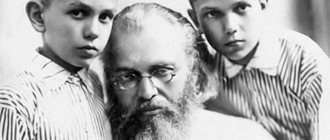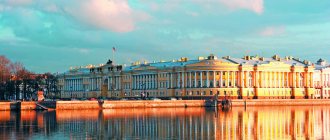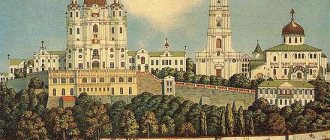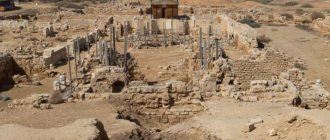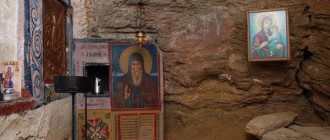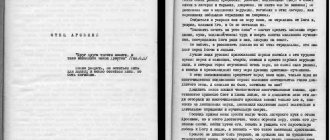| St. Nestor the Chronicler. Modern Russian icon |
Nestor the Chronicler
(+ 1113-1116 [1]), hagiographer, theologian, historian, venerable Memory of October 27, in the Councils of the Rev. Fathers of the Kiev-Pechersk Near Caves and all the Rev. Fathers of the Kiev-Pechersk, as well as Volyn and Kiev saints and in the Cathedral of Saints Kiev Theological Academy and Seminary (Ukr.)
At the beginning of the 12th century. Venerable died Nestor the Chronicler, who captured the bright image of the holy abbot Theodosius for the spiritual benefit of his descendants, and also took part in the work on the most ancient chronicle of Rus'.
Nestor's first works were the “Reading” about St.
Boris and Gleb and “Life” by Rev. Feodosia. The introduction to the Life says: “Having first written about the life, and the death, and the miracles of the holy and blessed passion-bearers Boris and Gleb, I forced myself to move on to another story. He exceeds my strength, and I remain unworthy of him, being rude and ignorant. Besides [I have not yet] been trained in [any] art. However, I remembered, Lord, Your following words: “If you have faith the size of a mustard seed and say to this mountain, “Move from here to there,” and it will move” (Matthew 17:20); “If anyone says to this mountain, “Be taken up and cast into the sea,” and does not doubt... it will be done for him whatever he says” (Mark 11:23); “If you had faith the size of a mustard seed and said to this fig tree, “Be uprooted and planted in the sea,” then it would listen to you” (Luke 17:6). And I, sinful Nestor, was comforted by the said thought, and strengthened by faith and hope that with Your assistance nothing is impossible, and laid the foundation for the word of Scripture. It is dedicated to the life of our Rev. Father Theodosius.”
| V. M. Vasnetsov. St. Nestor the chronicler. Sketch of the painting of the Vladimir Cathedral in Kyiv. Watercolor (1885-1893). State Tretyakov Gallery |
At the end of the “Life” we read:
“This was written down by me, sinful Nestor, the lowest of all in the monastery of our blessed father Theodosius. I was accepted into it by the Venerable Abbot Stephen. He also tonsured me, clothed me in monastic clothes, and even later elevated me to the rank of deacon.”
The eldest among the lists of “Readings” known today about St. Boris and Gleb was created in the 14th century. And “Life” by Rev. Theodosius was preserved in the “Uspensky Collection” of the 12th - 13th centuries. and later lists. Researchers date the composition of the “Life” to the 80s. XII century (the time the name of St. Theodosius was included in the general church synodik of Rus').
The “Message” of the Lavra monk Polycarp to Abbot Akindinus mentions that “Nestor, who appeared as the compiler of the chronicle,” together with other ascetics took part in the healing of St. Nikita, who voluntarily went into seclusion and became a victim of demonic seduction. A comparison of the data from the “Epistle” with the “Tale of Bygone Years” shows that the healing of St. Nikita happened in 1078. In his “Epistle” Polycarp says that “blessed Nestor told in the chronicle about the blessed fathers: about Damian and Ephraim, and Matthew, and Isaac.” The lives of the four listed saints are described in the “Tale of the first monks of Pechersk” from the chronicle article of 1074 in the “Tale of Bygone Years”. The Patericon of 1462 names St. Nestor, the author of chronicle stories about the founding of the Pechersk Monastery and the discovery of the relics of St. Feodosia. Dating back to the 16th century. In the Khlebnikov list of the Ipatiev Chronicle, the name of the “monk Nestor Feodosyev of the Pechersk monastery” is included in the title “Tale of Bygone Years” as the author. The father of the first of the ancient Russian chronicles was considered to be St. Nestor and writers of the 17th century. in Ukraine and Russia.
In the 18th century a critical study of chronicle texts began. As their research deepened, historians drew attention to the internal contradictions in the words of the “Tale of Bygone Years” and its disagreements with the “Life” of St. Theodosius regarding the history of the Pechersk monastery. In particular, at the end of “The Tale of the Beginning of the Pechersk Monastery,” having described the introduction of the cenobitic charter, the author Fr.
If this statement is taken for Nestorov, then it disagrees with the words of the ascetic about himself in the “Life” of St.
Feodosia. And in the “Sermon on the Transfer of the Relics of St. Theodosius,” the author, having told how he discovered the cave tomb of the holy abbot, adds: “I, your sinful disciple and slave, am at a loss how to praise you, your worthy life and deeds.”
| St. Nestor the Chronicler. Icon from the Kiev-Pechersk Lavra at the reliquary of the relics of the saint (19th century) |
The indicated inconsistencies between the “Tale” and the “Life” forced even some scientists at the beginning of the 19th century.
assume that Nestor the Chronicler and Nestor the Hagiographer were different persons. Opponents of these researchers took a different path. Thus, Metropolitan Evgeniy (Bolkhovitinov), Archbishop Filaret (Gumilevsky) and Metropolitan Macarius (Bulgakov) believed that St. Nestor stood with St. Feodosia only as a novice of the Pechersk Monastery, and took monastic vows and the rank of deacon under St. Stefan. In turn, A. Shakhmatov put forward a version according to which, firstly, St. Nestor was the editor of the chronicle code, which had already been created in the Lavra earlier and needed to be supplemented; secondly, it was St. Nestor gave the collection the name “Tale of Bygone Years”, and thirdly, contradicting the “Life” of St. Theodosius, the chronicler's instructions about himself do not belong to St. Nestor, and his predecessor in the design of the vault. At the same time, the scientist assumed that Rev. Nestor compiled only the first edition of the “Tale” in 1113, and later the abbot of the Kiev-Vydubitsky Monastery Sylvester worked on the code, whose postscript with reference to 1116 was preserved in the Laurentian Chronicle. Despite the clarifications made by researchers to the history diagram of The Tale of Bygone Years, this work, together with the Life of St. Feodosia remain true masterpieces of ancient Russian literature. They testify to St. Nestor as a prayer book for Rus', a hagiographer, theologian, historian with a rare gift of writing.
The relics of the ascetic rest in the Near Caves, where maps have indicated them since 1638 (in 1703 they were mistakenly signed with the words “Nestor the Recluse”). In 1826, a gilded copper plaque with the name of the saint of God, sent by the Society of Russian History and Antiquities, was installed above the shrine. Based on the results of the examination of the relics of St. Nestor in the 80s. V. Forensic expert S. Nikitin made a bust with the supposed appearance of the holy Chronicler.
The 8th hymn of the “Canon” of 1643 cries out: “Nestora the wise, the first writer of the lives of the saints, and a good zealot for them, to glory through your prayers show me a sinner!”
And in the 7th song of the canon “Services” to the saints of the Near Caves we read:
“The times and years of the many-wonderful church, the life and virtues of the first father revealed to us in writing, and the zealous former zealot of their deeds, the glorious Nestor, with them now we please you, we sing: Blessed be God our father!”
In the same collection, under October 27, there is a separate “Service” for the ascetic.
Prayers
Troparion, tone 4
The great princes of the Russians, the deeds/ and the venerable Father of Pechersk, who wrote the lives and miracles,/ but his own, to the God-Wise Nestor, of many, for the sake of virtues, the name/ was written in heaven, acquisitive,// they say and we too should write in the Book of Animals.
Troparion, tone 4
Times and years of memorable deeds,/ exploits and labors of the God-bearing fathers,/ writing to Nestore the Wise,/ you were kindled with love to follow in the footsteps of the first ones,/ with him do not cease to pray X I pray to God that our souls may be saved.
Kontakion, tone 2
As this God-bearing Theodosius is a disciple / and a true imitator of his life, / the first self-witness of his honest relics, you were honored to be, / who, with others, scrupulously carried, / inherited you with the same Kingdom of Heaven, / which we, who honor you, may also receive from the Lord.
Holy Scribe. Father of Russian history, Venerable Nestor the Chronicler
We do not know either the worldly name of the Venerable Nestor the Chronicler or his origin, however, much of what is known about Ancient Rus' was preserved by the pen of this very person - an outstanding hagiographer, compiler of the main ancient Russian chronicle - “The Tale of Bygone Years”, author of “Readings” about St. princes Boris and Gleb and “The Lives of St. Theodosius of Pechersk" - a literary masterpiece included in the "Kievo-Pechersk Patericon".
The future monk of the Kiev-Pechersk Monastery, the Venerable Nestor the Chronicler, was born in the 50s. XI century in Kyiv. As a young man he came to the Monk Theodosius (+1074, commemorated May 3) and became a novice, then a hierodeacon. The high spiritual life of Nestor is indicated by the fact that he, along with other reverend fathers, participated in the expulsion of a demon from Nikita the recluse (later the Novgorod saint, commemorated on January 31), who was seduced into Jewish wisdom.
The Monk Nestor deeply valued true knowledge, combined with humility and repentance. “There is great benefit from bookish teaching,” he said, “books punish and teach us the path to repentance, for from bookish words we gain wisdom and self-control. These are the rivers that water the universe, from which wisdom emanates. Books have innumerable depth, we console ourselves with them in sorrow, they are the bridle of abstinence. If you diligently search for wisdom in the books, you will gain great benefit for your soul. For he who reads books converses with God or holy men.”
Venerable Nestor the Chronicler
The Monk Nestor is the author of the biographies of the holy princes Boris, Gleb and the Monk Theodosius, the creator of the first edition of the Tale of Bygone Years - the so-called Primary Chronicle - the most ancient all-Russian chronicle collection. It describes the events from the time of the sons of Noah until the reign of Vladimir Monomakh in Kyiv in 1113. Nestor speaks of the first mention of the Russian people in church sources - in 866, under the holy Patriarch Photius of Constantinople; tells about the creation of the Slavic charter by Saints Cyril and Methodius, Equal-to-the-Apostles, and the Baptism of Saint Olga, Equal-to-the-Apostles in Constantinople. The chronicle of St. Nestor has preserved for us a story about the first Orthodox church in Kiev (under 945), about the confessional feat of the holy Varangian martyrs (under 983), about the “test of faith” by Saint Vladimir Equal-to-the-Apostles (986) and the Baptism of Rus' (988 G.). We owe the Russian church historian information about the first metropolitans of the Russian Church, about the emergence of the Pechersk monastery, about its founders and devotees.
It is interesting that historians express different opinions regarding the authorship of The Tale of Bygone Years. Nestor is supported by the mention of him in the letter to Archimandrite Akindinus (1224–1231) by the monk Polycarp and the existence of some lists with a direct indication of Nestor as the original author of the chronicle. But it is obvious that then Nestor’s work was supplemented more than once, rewritten and edited, absorbing echoes of further political struggle in Rus'. There is extensive specialized literature on this subject, but from recent research it is worth citing the words of Academician B.A. Rybakova: “Among the chroniclers, Nestor from Kiev (beginning of the 12th century) especially stands out. He wrote a broadly conceived historical introduction to the chronicle of events - The Tale of Bygone Years. The chronological range of introduction is from the V–VI centuries. AD until 860, when the Rus first emerged as a force equal to the Byzantine Empire. Nestor’s historical and geographical introduction to the history of Kievan Rus, written with unprecedented breadth and accuracy, deserves full confidence on our part” (“World of History”, M. 1982. P. 327).
Venerable Nestor the Chronicler. Engraving from the Patericon of 1702
Some historians, exploring the origins of the Norman theory of the emergence of Russian statehood, call Nestor the first Normanist, who asked the question “Where did the Russian land come from?” On this occasion, Academician Rybakov made an interesting remark: “The final editing of Nestor’s “Tale of Bygone Years” is carried out, according to Shakhmatov (Alexey Aleksandrovich Shakhmatov - an outstanding Russian linguist, historian of ancient culture - Ed.) around 1118 under the supervision of Prince Mstislav Vladimirovich, son Monomakh. The grandson (by mother) of the English king, the husband of the Varangian princess, the father-in-law of the Norwegian and Danish kings, the prince who spent twenty years in the north of Rus' in Novgorod, Mstislav was firmly connected with all of Northern Europe and it was from these positions that he looked at the history of Rus', exaggerating the role of the northerners -Varyags in her destinies. Wherever possible, Mstislav inserted legends about the Varangians, about the calling of the Varangian princes and identified the Varangians with the Russians, thereby becoming the founder of the erroneous and tendentious Norman theory.” (“Kievan Rus and Russian principalities of the 12th–13th centuries,” M. 1982, p. 8).
But what can we still say about the legendary Nestor from his works? “At the end of the 11th century. he lived in the Pechersky Monastery, writes V.O. Klyuchevsky (“Historical Portraits”, M., 1991). - Talking about the year 1096 about the Polovtsian raid on the Pechersky Monastery, he says: “... and when they came to the Pechersky Monastery, we, living in our cells, rested after matins.” Further we learn that the chronicler was still alive in 1106. This year, he writes, “the good old man Jan died, who lived 90 years, in a venerable old age, he lived according to the law of God, he was no worse than the first righteous, from him I heard a lot of words, even written in these chronicles.”
Ipatiev Chronicle page
Outstanding researcher of the chronicles of Ancient Rus' M.D. Priselkov dates the end of the “Tale...” to 1114–1116, while the “Reading” about Boris and Gleb and the “Life of Theodosius” were apparently written earlier than the “Tale of Bygone Years”.
M.D. Priselkov suggests that Nestor came to the monastery not as a young novice who had not seen life, but as a fairly authoritative person, lamenting his youth, filled with many sins. Nestor mentions this in the Life of Theodosius, which, in fact, contains most of the biographical information about the author himself. Thus, in particular, it becomes clear that in a fairly short period of time (about 4 years) of his stay in the monastery, Nestor managed to receive the rank of deacon, apparently due to the respect of Theodosius’ successor, Abbot Stephen, for his learning and literary talent. “If the fact that Nestor entered the monastery as an already educated and middle-aged man, on the one hand, causes in us a heightened regret that we know nothing about his life before the monastery and can only guess from what environment he came from, where received an education, what he did in the world and what led him to the decision to retire from the world, then, on the other hand, we have the right to conclude that Nestor, retiring from the world, consciously and deliberately stopped in choosing the place of his monastic exploits from all the abundance and diversity of monasteries , then existing in Kiev, precisely in Pechersky, in order to contribute their labor to the general work of the Feodosian herd, which was already quite glorious and definitely declared itself in the face of political and church authorities, as well as in the broad face of the then Russian public" ("Nestor the Chronicler" , St. Petersburg, 2009, p. 38).
MM. Antokolsky. Nestor the Chronicler. 1890
Vasily Osipovich Klyuchevsky draws attention to Nestor’s special historical view: “The scientific task of the historian, as it is now understood, is to understand the origin and development of human societies. The chronicler is much more interested in man himself, his earthly and especially afterlife... The pragmatic historian studies the genesis and mechanism of human coexistence; the chronicler looks for moral meaning and practical lessons for life in events; the objects of his attention are historical teleology and everyday morality. He looks at world events with the self-confident gaze of a thinker, for whom the mechanics of life are not a mystery: the forces and springs that drive human life are clear to him. ... The chronicler describes the invasions of the filthy on the Russian land, the troubles that it suffers from them. Why does God allow infidels to triumph over Christians? Do not think that God loves the former more than the latter: no, He allows the wicked to triumph over us not because He loves them, but because He has mercy on us and wants to make us worthy of His mercy, so that we, admonished by misfortunes, leave the path of wickedness. The filthy ones are the batog with which Providence corrects its children. “God will execute His servants with various plagues, fire and water and the army and other various executions; bring the peasant into the Kingdom of Heaven through many misfortunes.”
Thus, historical life serves as a moral and religious school in which a person must learn to learn the ways of Providence. ...Everything proclaims these paths, not only historical events, but also physical phenomena, especially extraordinary signs from heaven. Hence the chronicler’s intense interest in natural phenomena. In this respect, his program is even broader than that of the modern historian. For him, nature is directly involved in history, is not a source of spontaneous, often fatal influences that either excite or depress the human spirit, or even just the mute environment of human life. She herself is a living, active person in history, lives together with man, pleases him, and tells him the will of God with signs.
...So the chronicler is a moralist who sees in human life the struggle of two principles, good and evil, Providence and the devil, and considers man only as pedagogical material that Providence educates, directing him to the high goals destined for him” (“Historical Portraits”, M ., 1991).
The Monk Nestor died around 1114, bequeathing to the Pechersk monks-chroniclers the continuation of his great work. His successors in the chronicle were Abbot Sylvester, Abbot Moses Vydubitsky, who extended it until 1200, and finally, Abbot Lavrenty, who in 1377 wrote the oldest copy that has come down to us, preserving the “Tale” of St. Nestor (“Laurentian Chronicle”). The heir to the hagiographic tradition of the Pechersk ascetic was St. Simon, Bishop of Vladimir (+1226, commemorated May 10).
The Monk Nestor was buried in the Near Caves of the Monk Anthony of Pechersk. The Church also honors his memory together with the Council of Fathers, who rest in the Near Caves, on September 28 and on the 2nd Week of Great Lent, when the Council of all Kiev-Pechersk Fathers is celebrated.
His works have been published many times. Latest scientific publications: “The Tale of Bygone Years”, M.-L., 1950: “The Life of Theodosius of Pechersk” - in “Izbornik” (M., 1969; parallel to the Old Russian text and modern translation).
Theodore Scutariot
The Byzantine chronicler of the 13th century, Theodore Scutariot, witnessed many historical events. He took part in the war between Byzantium and Bulgaria, visited the popes and witnessed the reign of several emperors.
Byzantium at the beginning of the 13th century. (wikipedia.org)
The Chronicle, attributed to Theodore Scutariot, was anonymous, but the 19th-century German scientist August Heisenberg concluded that Scutariot could be considered its author. The Chronicle describes events up to and including 1261. From the work you can glean information, including about the foreign policy of Byzantium.
Early years
To find the answer to the question “Who is Nestor the Chronicler?”, it is necessary to track the biography of the historical character. Unfortunately, he lived in those distant times about which little is currently known. An important role was played by the fact that Nestor, like a true monk, led a solitary lifestyle.
Presumably, Nestor was born in 1056, on White Lake. Apparently, his family was quite wealthy, since the boy received a decent education, which at that time was a sign of special social status and wealth.
Successors
Dying, the elder bequeathed the development of his grandiose story to other monks of the Kiev-Pechersk Monastery. His followers were Abbot Sylvester, who designed The Tale of Bygone Years in its modern form, and Abbot Moisei Vydubitsky, who continued it until the thirteenth century. And, in addition, Abbot Lavrenty. This chronicler in 1377 created the so-called “Laurentian Chronicle” - the most ancient of the lists that have survived to this day, preserving the “Tale”, on which the reverend Pechersk ascetic Nestor the Chronicler worked. A photo of this priceless relic is available to everyone, and it itself is stored in the Russian National Library in St. Petersburg. The heir to the hagiographical tradition of Nestor was Simon, Bishop of Vladimir.

